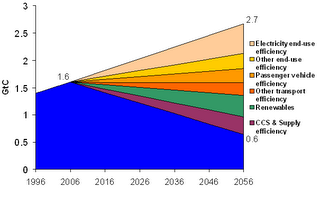Carbon Stabilization Wedges
 I am really digging this plan to stabilize carbon emissions put out by Robert Socolow. In my review of An Inconvenient Truth I lamented the fact that Gore laid out no plan on how to deal with global warming and carbon emissions. Socolow's plan was what I was looking for. He lays out what needs to be done, a time frame to do it in, the approximate costs it would take to make it happen, and different ways the goal can be achieved.
I am really digging this plan to stabilize carbon emissions put out by Robert Socolow. In my review of An Inconvenient Truth I lamented the fact that Gore laid out no plan on how to deal with global warming and carbon emissions. Socolow's plan was what I was looking for. He lays out what needs to be done, a time frame to do it in, the approximate costs it would take to make it happen, and different ways the goal can be achieved.
The goal is to stabilize carbon dioxide emissions from 2006 to 2056 and then to cut the 2056 emissions in half over the next 50 years.
From Science (if you can't access it, try clicking on the link from this page):Very roughly, stabilization at 500 ppm requires that emissions be held near the present level of 7 billion tons of carbon per year (GtC/year) for the next 50 years, even though they are currently on course to more than double.
He shows 15 possible wedges. Examples include:
To keep the focus on technologies that have the potential to produce a material difference by 2054, we divide the stabilization triangle into seven equal "wedges." A wedge represents an activity that reduces emissions to the atmosphere that starts at zero today and increases linearly until it accounts for 1 GtC/year of reduced carbon emissions in 50 years.-Increase fuel economy for 2 billion cars from 30 to 60 mpg
-Cut carbon emissions by one-fourth in buildings and appliances projected for 2054
-Introduce Carbon Capture and Storage at 800 GW coal or 1600 GW natural gas
-Decrease tropical deforestation to zero instead of 0.5 GtC/year, and establish 300 Mha of new tree plantations
In Scientific American he lays out the cost of this plan. A carbon tax needed to jump start this transition is in the ballpark of $100-$200 per ton of carbon. One ton of carbon is carried in 2.7 tons of CO2 so this price is equivalent to $27 per ton of CO2. Based on carbon content $100 per ton of carbon is $12 per barrel of oil and $60 per ton of coal. It is $.25 per gallon of gasoline and 2 cents per kWh of electricity from coal. These are not trivial costs, but they are not back breaking either.
The plan calls for a 60% reduction in OECD nations by 2050 which would allow non-OECD to emit 60% more. Even by doing this the OECD countries will still be emitting 2 times as much per capita. What it would take for the US to hit that reduction is laid out in this Scientific American article.
What it would take for the US to hit that reduction is laid out in this Scientific American article.
There are more write ups on this idea, see World Changing, The Economist and a second Economist article. This is a nice slide show of the key points.
Some believe that the estimate of 7 wedges is too low, that it might actually be closer to 29. I don't know enough to judge, but even if this were true then you could still keep the same framework, but just implement more changes quicker.
Implementing the wedges will have benefits beyond global warming and carbon dioxide emissions. Reducing oil and natural gas usage will make the United States less dependant on dangerous parts of the world. Reducing our usage of coal will have many health and environmental benefits by limiting mercury emissions, reducing acid rain, minimizing other air pollutants and stopping the dangerous and environmentally damaging mining. Stopping deforestation and implementing reforestation will make the world better for nature.
This is the first comprehensive plan I have seen describing what it would take to stabilize carbon emissions. I like the idea of trying to stabilize emissions over the next 50 years while bringing the developing world into modern economies. Then over the next 50 years carbon emissions we can try and reduce those emissions. I think the breakdown of how much industrialized countries need to cut back vs. developing nations is fair, but this can be debated. There are costs to the plan but they are not overwhelming. If nothing else this seems like an excellent place to start in determining how to combat global warming.





No comments:
Post a Comment
Note: Only a member of this blog may post a comment.